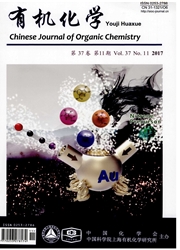

 中文摘要:
中文摘要:
利用同位素取代法考察了[Bmim]Br-AlCl3催化苯与1-十二烯烃烷基化反应机理.首先进行了[Bmim]Br-AlCl3催化氘代苯与1-十二烯烃的反应,通过GC-MS及NMR分析产物十二烷基苯同分异构体的结构,验证了氘原子与产物侧链1-位碳相连的结论.示踪氘原子推导了烷基化反应机理,结果表明:[Bmim]Br-AlCl3催化苯与长链烯烃的烷基化反应是由[Al2Cl6Br]-发生平衡移动,生成Lewis酸AlCl3引发的;AlCl3吸电子作用使1-十二烯烃的π电子向1-碳转移,在烯烃的2-碳上形成正电荷中心,碳正离子与苯发生亲电反应生成不稳定的σ络合物,与σ络合物环上的σ-C相连的D+转移到负电的侧链1-C上形成C—D键,AlCl3离去,生成产物2-十二烷基苯.Lewis酸催化机理为离子液体催化苯与长链烯烃的反应中,2-十二烷基苯选择性高于H质子催化产物提供了理论依据.
 英文摘要:
英文摘要:
Alkylation mechanism of benzene with 1-dodecene in [Bmim]Br-AlCl3 was investigated. Alkylation of C6D6 with 1-dodecene using [Bmim]Br-ALCl3 as a catalyst was firstly carried out. Molecular structures of products, dodecylbenzene isomers, were analyzed by GC-MS and NMR, and the deuterated atom in the dodecylbenzenes was verified to be connected with 1-carbon of the side chain. Alkylation mechanism was deduced by tracing the deuterated atom. Results demonstrated that alkylation was induced by AlCl3, which was generated by the dissociation of [Al2Cl6Br]^-. The role of AlCl3 in attracting electrons pushs n electrons to 1-carbon of 1-dodecene, and the positive center is formed at 2-carbon. The carbonium ion reacts with benzene to form a σ complex, which is instable and D+ connected to the σ carbon of ring is transferred into electronegative 1-C of the side chain to form a C--D bond, accordingly AlCl3 leaves. 2-Dodecylbenzene is formed. The Lewis acid mechanism provides the evidences for the higher selectivity of 2-dodecylbenzene using ionic liquid as catalyst than that using H^+ as catalyst.
 同期刊论文项目
同期刊论文项目
 同项目期刊论文
同项目期刊论文
 Effects of additives on the properties of chloroaluminate ionic liquids catalyst for Alkylation of i
Effects of additives on the properties of chloroaluminate ionic liquids catalyst for Alkylation of i Separation of Ethyl Acetate and Ethanol by Room Temperature Ionic Liquids with the Tetrafluoroborate
Separation of Ethyl Acetate and Ethanol by Room Temperature Ionic Liquids with the Tetrafluoroborate DFT studies on the isomerization of butene double bond catalyzed by 1-butyl-3-methyl- imidazolium in
DFT studies on the isomerization of butene double bond catalyzed by 1-butyl-3-methyl- imidazolium in A DFT study on the double bond migration of butene catalyzed by ionic pair of 1-ethyl-3-methyl-imida
A DFT study on the double bond migration of butene catalyzed by ionic pair of 1-ethyl-3-methyl-imida Alkylation of isobutane and butene using chloroaluminate imidazolium ionic liquid as catalyst: Effec
Alkylation of isobutane and butene using chloroaluminate imidazolium ionic liquid as catalyst: Effec 期刊信息
期刊信息
